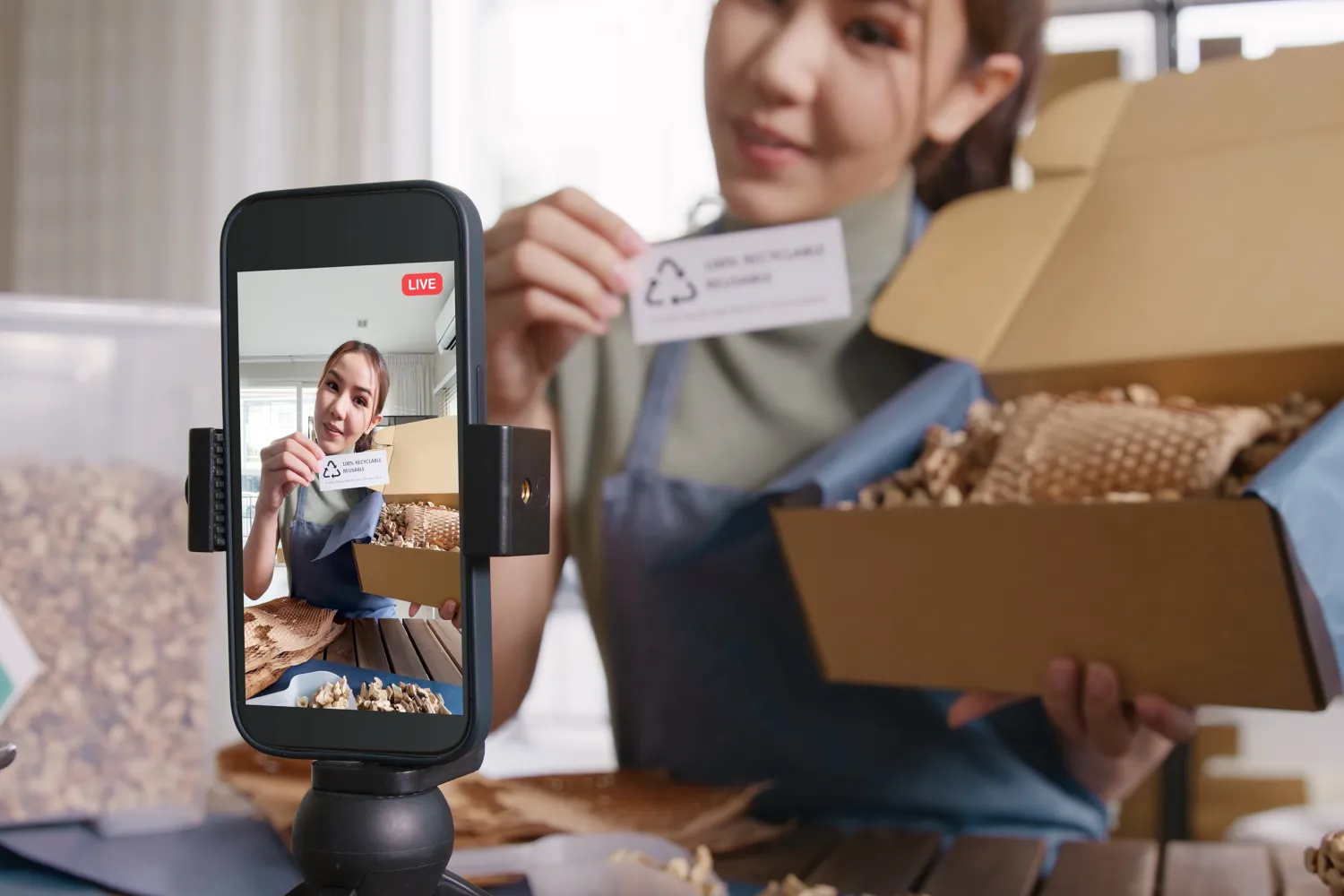7 Types of Influencer and How To Use Them With Examples

As social media platforms continue to burgeon, so does the variety of influencers who populate them. In this landscape, businesses and brands face the crucial task of identifying the right type of influencer to align with their marketing objectives.
The effectiveness of influencer marketing hinges not just on reach but on relevance and authenticity. Today, we investigate the vast world of influencers, categorizing them into seven distinct types.
From mega influencers with their vast reach to niche nano influencers with their highly engaged audiences, we explore each category and provide concrete examples of how they can be strategically used in marketing campaigns.
1. Mega Influencers
Mega influencers are the giants of the influencer world. With their follower counts often in the millions, these individuals are typically celebrities, sports stars, or renowned public figures. Their vast reach makes them ideal for campaigns that aim for high visibility and broad awareness.
Characteristics
Mega influencers have a global appeal and are recognized across various demographics. Their endorsement can lend significant credibility and prestige to a brand. However, their broad appeal might not always translate into deep engagement, as their diverse audience is not necessarily aligned with a specific niche.
Ideal Use
These influencers are best used when a brand wants to create a significant impact, perhaps launching a new product or entering a new market. Their endorsement can quickly generate buzz and attract attention on a large scale.
Example
Consider a global tech company unveiling its latest smartphone. By partnering with a mega influencer like a globally recognized movie star or a celebrated athlete, the company can associate their product with high status and desirability. The launch event, coupled with social media posts and advertisements featuring this influencer, would gain immediate and widespread attention, propelling the product into the spotlight.
2. Macro Influencers
Macro influencers occupy a sweet spot in the influencer hierarchy. With follower counts ranging typically from 100,000 to a million, they offer a balance between significant reach and targeted influence. These influencers are often subject matter experts, popular bloggers, or rising stars in entertainment and sports.
Characteristics
Macro influencers tend to have a more defined and dedicated audience compared to mega influencers. This allows for a deeper level of engagement and credibility within their specific domains. They are recognized for their expertise or influence in particular fields, which can range from fashion and beauty to gaming and fitness.
Ideal Use
Macro influencers are well-suited for campaigns that target specific demographic groups or interest areas. They are particularly effective for brands looking to establish a strong presence in a particular market segment or for product launches that appeal to specific interests.
Example
A sports apparel brand looking to promote a new line of running gear would benefit from partnering with a well-known fitness guru who is a macro influencer. Their endorsement would not only bring visibility to the product but would also carry the weight of their expertise and credibility in fitness, appealing directly to fitness enthusiasts.
3. Micro Influencers
Micro influencers represent a more niche approach in the influencer marketing spectrum. Typically, they have a follower count ranging from 1,000 to 100,000. What they lack in sheer numbers, they make up for in high engagement rates and a close-knit community feel.
Characteristics
Micro influencers are often seen as more relatable and authentic by their followers. They tend to strongly connect with their audience, fostered through regular, personalized interactions. Their recommendations are often perceived as more trustworthy and genuine.
Ideal Use
Micro influencers are excellent for brands that aim to build trust and loyalty within a specific niche. They are particularly effective for local or community-based marketing campaigns or for products and services that require a more personal touch.
Example
Consider a new artisanal coffee shop opening in a city. Collaborating with a local food blogger who is a micro-influencer can help create buzz within the community. Their authentic portrayal of the coffee shop’s unique ambiance and offerings would resonate strongly with their local followers, driving foot traffic and fostering a loyal customer base.
4. Nano Influencers
Nano influencers are the grassroots voices of the influencer world. Typically having a follower count between 1,000 and 10,000, they might not have the expansive reach of their larger counterparts, but they boast highly engaged and localized audiences.
Characteristics
Nano influencers are often characterized by their authenticity and high levels of engagement. They usually have a strong connection with their audience, often interacting directly and personally. Their influence is rooted in their perceived approachability and trustworthiness among their followers.
Ideal Use
Nano influencers are perfect for hyper-local or community-driven campaigns. They create a genuine buzz around a product or service and are especially effective for brands looking to build a grassroots presence or tap into specific local communities.
Example
A local organic skincare brand can partner with nano influencers who are passionate about natural wellness and beauty. These influencers can share their genuine experiences with the products, creating an authentic and relatable narrative that resonates strongly with their audience, thus fostering a loyal local customer base for the brand.
5. Blog Influencers
Blog influencers have carved out their niche by creating content that offers depth, insight, and often a personal touch. They tend to have dedicated followings and are respected for their comprehensive and detailed content on various subjects, from fashion and travel to technology and lifestyle.
Characteristics
Blog influencers are known for their ability to craft detailed and informative content. They often have a significant impact on their readers’ opinions and decisions due to the trust they’ve built over time. Their content is usually well-researched and offers a mix of personal anecdotes and professional advice.
Ideal Use
Blog influencers are ideal for campaigns that require in-depth storytelling, detailed product reviews, or content that benefits from a personal touch. They are also beneficial for enhancing a brand’s SEO strategy through backlinks and keyword-rich content.
Example
A travel agency launching a new exotic destination package can collaborate with a travel blog influencer. The influencer can create a series of detailed blog posts and social media content, sharing their personal experiences of the destination, complete with beautiful photography and practical tips. This comprehensive portrayal can entice readers to book similar trips, leveraging the influencer’s credibility and detailed content.
6. Social Media Stars
Social media stars are influencers who have risen to prominence primarily through platforms like Instagram, TikTok, YouTube, and Snapchat. Their follower counts can vary widely, but they are typically known for their high engagement rates and their ability to set trends among their followers.
Characteristics
Social media stars are adept at creating content that resonates with and entertains their audience. They often have a strong personal brand, characterized by a specific style or theme. Their content is usually visually appealing, trendy, and aligns with the interests of a younger demographic.
Ideal Use
These influencers are perfect for brands looking to create viral content, launch new products, or target younger audiences. They are particularly effective in industries like fashion, beauty, entertainment, and technology.
Example
A beauty brand launching a new line of eco-friendly makeup products can collaborate with a social media star known for their vibrant and creative makeup tutorials on YouTube. The influencer can create engaging content showcasing the versatility and benefits of the new products, tapping into their substantial and engaged following, and generating buzz and excitement around the launch.
7. Thought Leaders
Thought leaders are influencers recognized for their expertise and authority in a particular field or industry. They might be CEOs, industry experts, academics, or professionals who have built a reputation for their insights and thought leadership.
Characteristics
Thought leaders are respected for their depth of knowledge and often influence the decision-making of others in their field. They typically share content that is educational, insightful, and adds value to their industry or area of expertise.
Ideal Use
Thought leaders are best suited for B2B marketing, professional services, and brands looking to establish credibility and authority in a specific field. They can be leveraged for speaking engagements, webinars, and content collaborations that require a high level of expertise and trust.
Example
A software company specializing in AI technology can partner with a thought leader in the AI industry for a series of webinars and blog posts. This collaboration allows the company to tap into the influencer's credibility and expertise, positioning their products at the forefront of industry discussions and reaching a professional audience that values expert opinions.
Harnessing Influencer Power for Impactful Marketing
The realm of influencer marketing is varied — from the widespread appeal of mega influencers to the niche authenticity of nano influencers, each type offers unique advantages and opportunities for brands to connect with audiences in meaningful ways.
The key to successful influencer marketing lies in understanding these distinctions and aligning your brand’s objectives with the right influencer type. Whether creating broad awareness, tapping into specific markets, or building credibility and trust, there’s an influencer for every marketing need.
Connect with GR0 today to master influencer marketing and take your brand to new heights with our full range of digital marketing services.
Sources:
What It Really Means (And Takes) To Become A Thought Leader | Forbes
The Rise of Nano-Influencers: How the Smallest Voices are Making the Biggest Impact | Entrepreneur
16 Influencer Marketing Trends That Will Shape 2024 | Influencer Marketing Hub
Types of Social Media Influencers: Mega, Macro, Micro or Nano | CMS Wire
Table of Contents
As social media platforms continue to burgeon, so does the variety of influencers who populate them. In this landscape, businesses and brands face the crucial task of identifying the right type of influencer to align with their marketing objectives.
The effectiveness of influencer marketing hinges not just on reach but on relevance and authenticity. Today, we investigate the vast world of influencers, categorizing them into seven distinct types.
From mega influencers with their vast reach to niche nano influencers with their highly engaged audiences, we explore each category and provide concrete examples of how they can be strategically used in marketing campaigns.
1. Mega Influencers
Mega influencers are the giants of the influencer world. With their follower counts often in the millions, these individuals are typically celebrities, sports stars, or renowned public figures. Their vast reach makes them ideal for campaigns that aim for high visibility and broad awareness.
Characteristics
Mega influencers have a global appeal and are recognized across various demographics. Their endorsement can lend significant credibility and prestige to a brand. However, their broad appeal might not always translate into deep engagement, as their diverse audience is not necessarily aligned with a specific niche.
Ideal Use
These influencers are best used when a brand wants to create a significant impact, perhaps launching a new product or entering a new market. Their endorsement can quickly generate buzz and attract attention on a large scale.
Example
Consider a global tech company unveiling its latest smartphone. By partnering with a mega influencer like a globally recognized movie star or a celebrated athlete, the company can associate their product with high status and desirability. The launch event, coupled with social media posts and advertisements featuring this influencer, would gain immediate and widespread attention, propelling the product into the spotlight.
2. Macro Influencers
Macro influencers occupy a sweet spot in the influencer hierarchy. With follower counts ranging typically from 100,000 to a million, they offer a balance between significant reach and targeted influence. These influencers are often subject matter experts, popular bloggers, or rising stars in entertainment and sports.
Characteristics
Macro influencers tend to have a more defined and dedicated audience compared to mega influencers. This allows for a deeper level of engagement and credibility within their specific domains. They are recognized for their expertise or influence in particular fields, which can range from fashion and beauty to gaming and fitness.
Ideal Use
Macro influencers are well-suited for campaigns that target specific demographic groups or interest areas. They are particularly effective for brands looking to establish a strong presence in a particular market segment or for product launches that appeal to specific interests.
Example
A sports apparel brand looking to promote a new line of running gear would benefit from partnering with a well-known fitness guru who is a macro influencer. Their endorsement would not only bring visibility to the product but would also carry the weight of their expertise and credibility in fitness, appealing directly to fitness enthusiasts.
3. Micro Influencers
Micro influencers represent a more niche approach in the influencer marketing spectrum. Typically, they have a follower count ranging from 1,000 to 100,000. What they lack in sheer numbers, they make up for in high engagement rates and a close-knit community feel.
Characteristics
Micro influencers are often seen as more relatable and authentic by their followers. They tend to strongly connect with their audience, fostered through regular, personalized interactions. Their recommendations are often perceived as more trustworthy and genuine.
Ideal Use
Micro influencers are excellent for brands that aim to build trust and loyalty within a specific niche. They are particularly effective for local or community-based marketing campaigns or for products and services that require a more personal touch.
Example
Consider a new artisanal coffee shop opening in a city. Collaborating with a local food blogger who is a micro-influencer can help create buzz within the community. Their authentic portrayal of the coffee shop’s unique ambiance and offerings would resonate strongly with their local followers, driving foot traffic and fostering a loyal customer base.
4. Nano Influencers
Nano influencers are the grassroots voices of the influencer world. Typically having a follower count between 1,000 and 10,000, they might not have the expansive reach of their larger counterparts, but they boast highly engaged and localized audiences.
Characteristics
Nano influencers are often characterized by their authenticity and high levels of engagement. They usually have a strong connection with their audience, often interacting directly and personally. Their influence is rooted in their perceived approachability and trustworthiness among their followers.
Ideal Use
Nano influencers are perfect for hyper-local or community-driven campaigns. They create a genuine buzz around a product or service and are especially effective for brands looking to build a grassroots presence or tap into specific local communities.
Example
A local organic skincare brand can partner with nano influencers who are passionate about natural wellness and beauty. These influencers can share their genuine experiences with the products, creating an authentic and relatable narrative that resonates strongly with their audience, thus fostering a loyal local customer base for the brand.
5. Blog Influencers
Blog influencers have carved out their niche by creating content that offers depth, insight, and often a personal touch. They tend to have dedicated followings and are respected for their comprehensive and detailed content on various subjects, from fashion and travel to technology and lifestyle.
Characteristics
Blog influencers are known for their ability to craft detailed and informative content. They often have a significant impact on their readers’ opinions and decisions due to the trust they’ve built over time. Their content is usually well-researched and offers a mix of personal anecdotes and professional advice.
Ideal Use
Blog influencers are ideal for campaigns that require in-depth storytelling, detailed product reviews, or content that benefits from a personal touch. They are also beneficial for enhancing a brand’s SEO strategy through backlinks and keyword-rich content.
Example
A travel agency launching a new exotic destination package can collaborate with a travel blog influencer. The influencer can create a series of detailed blog posts and social media content, sharing their personal experiences of the destination, complete with beautiful photography and practical tips. This comprehensive portrayal can entice readers to book similar trips, leveraging the influencer’s credibility and detailed content.
6. Social Media Stars
Social media stars are influencers who have risen to prominence primarily through platforms like Instagram, TikTok, YouTube, and Snapchat. Their follower counts can vary widely, but they are typically known for their high engagement rates and their ability to set trends among their followers.
Characteristics
Social media stars are adept at creating content that resonates with and entertains their audience. They often have a strong personal brand, characterized by a specific style or theme. Their content is usually visually appealing, trendy, and aligns with the interests of a younger demographic.
Ideal Use
These influencers are perfect for brands looking to create viral content, launch new products, or target younger audiences. They are particularly effective in industries like fashion, beauty, entertainment, and technology.
Example
A beauty brand launching a new line of eco-friendly makeup products can collaborate with a social media star known for their vibrant and creative makeup tutorials on YouTube. The influencer can create engaging content showcasing the versatility and benefits of the new products, tapping into their substantial and engaged following, and generating buzz and excitement around the launch.
7. Thought Leaders
Thought leaders are influencers recognized for their expertise and authority in a particular field or industry. They might be CEOs, industry experts, academics, or professionals who have built a reputation for their insights and thought leadership.
Characteristics
Thought leaders are respected for their depth of knowledge and often influence the decision-making of others in their field. They typically share content that is educational, insightful, and adds value to their industry or area of expertise.
Ideal Use
Thought leaders are best suited for B2B marketing, professional services, and brands looking to establish credibility and authority in a specific field. They can be leveraged for speaking engagements, webinars, and content collaborations that require a high level of expertise and trust.
Example
A software company specializing in AI technology can partner with a thought leader in the AI industry for a series of webinars and blog posts. This collaboration allows the company to tap into the influencer's credibility and expertise, positioning their products at the forefront of industry discussions and reaching a professional audience that values expert opinions.
Harnessing Influencer Power for Impactful Marketing
The realm of influencer marketing is varied — from the widespread appeal of mega influencers to the niche authenticity of nano influencers, each type offers unique advantages and opportunities for brands to connect with audiences in meaningful ways.
The key to successful influencer marketing lies in understanding these distinctions and aligning your brand’s objectives with the right influencer type. Whether creating broad awareness, tapping into specific markets, or building credibility and trust, there’s an influencer for every marketing need.
Connect with GR0 today to master influencer marketing and take your brand to new heights with our full range of digital marketing services.
Sources:
What It Really Means (And Takes) To Become A Thought Leader | Forbes
The Rise of Nano-Influencers: How the Smallest Voices are Making the Biggest Impact | Entrepreneur
16 Influencer Marketing Trends That Will Shape 2024 | Influencer Marketing Hub
Types of Social Media Influencers: Mega, Macro, Micro or Nano | CMS Wire


Let's get started
We’re so excited to bring your story to life. What can we do for you?



